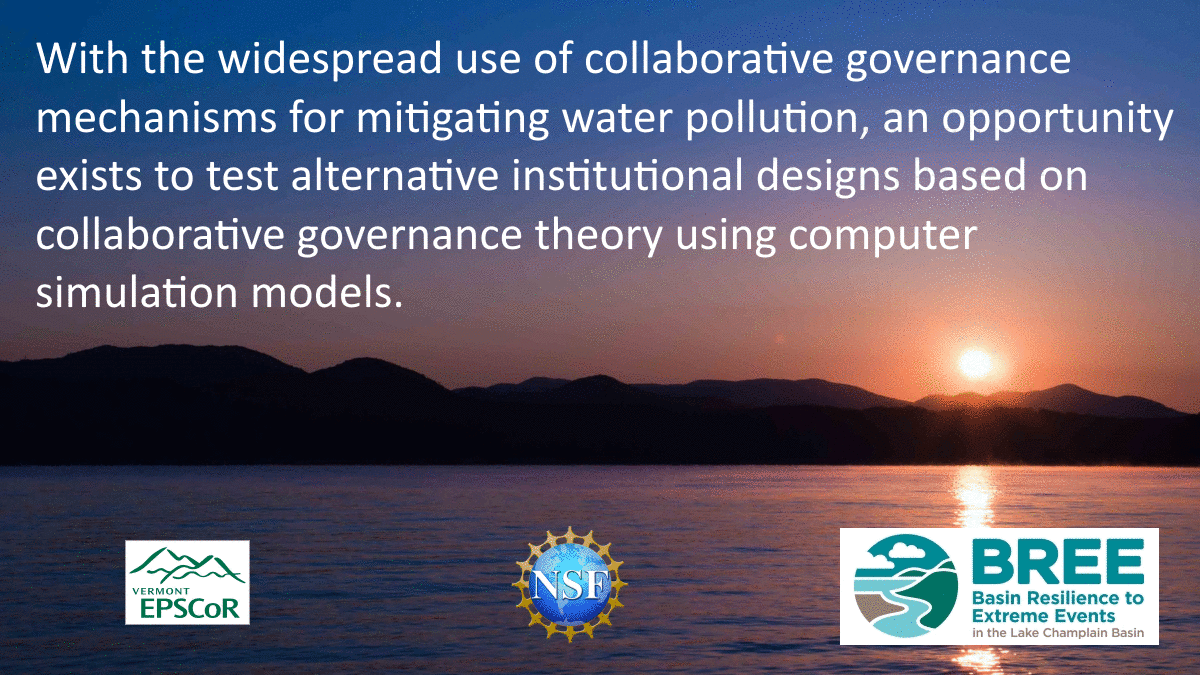

In Fall 2020, vital components of Vermont’s new law to protect state waterways from pollution, Act 76, will go into effect. Significant aspects of that law were drawn from a study conducted by an interdisciplinary team of researchers based at the University of Vermont as part of the National Science Foundation funded Vermont Established Program to Stimulate Competitive Research (VT EPSCoR). And the results of that study can now be read in a paper recently published in Journal of Public Administration Research and Theory.
The paper, titled “Modeling Alternative Collaborative Governance Designs: An Agent-Based Model of Water Governance in the Lake Champlain Basin,” was co-authored by Drs. Christopher Koliba (University of Vermont) and Patrick Bitterman (formerly UVM, now University of Nebraska-Lincoln). It documents the team’s efforts to determine what governing structure could most effectively manage the protection Vermont’s streams, rivers, and lakes. What roles should state, regional, and local governments and organizations each assume to ensure the best overall results? To answer this question, the research team made novel use of quantitative models and game theory traditionally applied to other negotiation and decision-making scenarios.
Two officials from the Vermont Agency of Natural Resources, Julie Moore, the Agency's Secretary, and Neil Kamman, who at the time was the Agency's Policy Director, attended regular advisory meetings for the UVM research program that housed this study. And when Vermont passed the Clean Water Act, Act 64, in 2015, Moore and Kamman realized that the UVM study could prove very useful. Act 64 set broad targets for protecting waterways throughout the state from pollution. But it left it for state officials to figure out how exactly to achieve that goal.
Moore and Kamman formed an informal partnership with the researchers to see if the study could help them design the state’s approach to this challenge. "Secretary Moore came to us and said, 'this is what we need to know,'" says Dr. Koliba. It was valuable information that helped ensure the results of the study would be as relevant as possible to the Agency's needs. The researchers in turn identified state data that could be most useful for building out their models, and were quickly given access to that information. "It allowed us to turn what would otherwise be a 'toy' model for making more generalized observations, into something that could be immediately more useful," notes Dr. Koliba.
What eventually emerged from the Vermont statehouse was a law that very clearly reflects the findings as presented by Dr. Koliba and Dr. Bitterman in their paper. It’s Act 76, the Clean Water Service Delivery Act, which was passed in May 2019. Act 76 establishes a cascading distribution of control and resources to manage waterway protection. One all parts of the law are in place, the state ANR will set the mandates for pollution reduction. Specific decisions regarding how to best meet those targets will then be delegated to five regional "Clean Water Service Providers" (CWSPs). Each CWSP will oversee a different region in the state, divided to cover the watershed areas of the Winooski River, the Missisquoi River, the Lamoille River, Otter Creek, and the lower basin area.
The CWSPs in turn will be composed of representatives from a variety of regional and local organizations and municipalities including towns, cities, watershed protection groups, conservation districts, and planning commissions. The CWSPs will gather and prioritize proposals for projects such as riverside buffers, tree plantings, stormwater control projects, and wetlands restoration, and then work with its local partners to plan, fund, and execute each project. The Vermont ANR is now in the process of selecting the organizations that will serve as the five CWSPs. They are expected to be announced, and to begin their work, in Fall 2020.
The research study documented above was conducted as part of UVM’s Basin Resilience to Extreme Events (BREE) program, an interdisciplinary research program designed to study the current and future health of Lake Champlain, its watershed area, and the people in that watershed. BREE, in turn, is made possible by the Vermont EPSCoR Program, which is funded by the National Science Foundation. For more information on this study, BREE, and the Vermont EPSCoR Program, please contact www.uvm.edu/EPSCoR
The paper is available via open access:
https://academic.oup.com/jpart/article/30/4/636/5820199